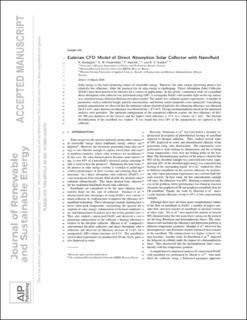| dc.contributor.author | Bårdsgård, Runa By | |
| dc.contributor.author | Kuzmenkov, Dmitriy M. | |
| dc.contributor.author | Kosinski, Pawel Jan | |
| dc.contributor.author | Balakin, Boris | |
| dc.date.accessioned | 2021-05-27T08:41:16Z | |
| dc.date.available | 2021-05-27T08:41:16Z | |
| dc.date.created | 2020-08-24T13:13:18Z | |
| dc.date.issued | 2020 | |
| dc.identifier.issn | 1941-7012 | |
| dc.identifier.uri | https://hdl.handle.net/11250/2756545 | |
| dc.description.abstract | Solar energy is the most promising source of renewable energy. However, the solar energy harvesting process has relatively low efficiency, while the practical use of solar energy is challenging. Direct absorption solar collectors (DASC) have been proved to be effective for a variety of applications. In this article, a numerical study of a nanofluid direct absorption solar collector was performed using computational fluid dynamics (CFD). A rectangular DASC with incident light on the top surface was simulated using an Eulerian–Eulerian two-phase model. The model was validated against experiments. A number of parameters such as collector height, particle concentration, and bottom surface properties were optimized. Considering particle concentration, we observed that the optimum volume fraction of particles for enhancing efficiency was obtained for 0.3 wt. %, and a decrease in efficiency was observed for ≥0.5 wt. %. Design recommendations based on the numerical analysis were provided. The optimum configuration of the considered collector reaches the best efficiency of 68% for 300 μm thickness of the receiver and the highest total efficiency is 87% at a velocity of 3 cm/s. The thermal destabilization of the nanofluid was studied. It was found that over 10% of the nanoparticles are captured in the collector. | en_US |
| dc.language.iso | eng | en_US |
| dc.publisher | AIP | en_US |
| dc.title | Eulerian CFD model of direct absorption solar collector with nanofluid | en_US |
| dc.type | Journal article | en_US |
| dc.type | Peer reviewed | en_US |
| dc.description.version | acceptedVersion | en_US |
| dc.rights.holder | Copyright 2020 AIP Publishing | en_US |
| dc.source.articlenumber | 033701 | en_US |
| cristin.ispublished | true | |
| cristin.fulltext | postprint | |
| cristin.qualitycode | 1 | |
| dc.identifier.doi | 10.1063/1.5144737 | |
| dc.identifier.cristin | 1824794 | |
| dc.source.journal | Journal of Renewable and Sustainable Energy | en_US |
| dc.source.40 | 12:033701 | |
| dc.source.14 | 3 | |
| dc.identifier.citation | Journal of Renewable and Sustainable Energy. 2020, 12(3), 033701 | en_US |
| dc.source.volume | 12 | en_US |
| dc.source.issue | 3 | en_US |
